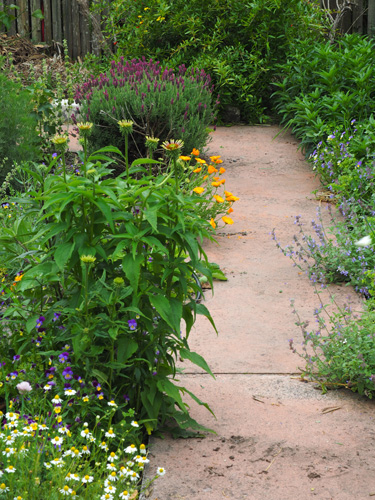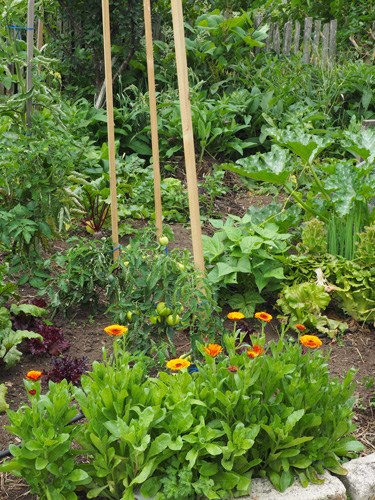Treading lightly
Growing our own food at home goes hand in hand with reducing our environmental footprint. Sue Linn visits a Katikati gardener with a passion for permaculture.
During the COVID-19 lockdown, Anne Billing was inspired by a sense of nature’s comeback.“It was exciting that skies cleared in such a short space of time. It gives me hope that we can restore some kind of balance between humans and nature.” The keen gardener and environmentalist is a staunch advocate for growing our own food, both for the sake of our health and to reduce the drivers of climate change.
“The lockdown proved we actually can cut our carbon emissions and see results quickly,” says Anne. “And if we recycle our food scraps at home we are creating a loop that sees nutrients being put back in the soil while reducing methane emissions from landfills.”
Anne says growing our own food makes it easier to live without plastics and packaging, and that we can garden without polluting our soil or harming the balance of nature. When not busy in her garden, Anne is actively involved as a member of the Enviro-Katikati Charitable Trust, Katikati Taiao. A global pandemic was far from their minds when the all-embracing community project was set up three years ago to support and link the region’s many environmental, social and cultural projects. Now with the sudden crisis we all face, a greater sense of community has never seemed more relevant and Katikati Taiao is well placed to respond.
In the days leading up to the Level 4 lockdown, issues around food security and a shortage of seedlings sparked a new KatiKati Taiao initiative. The garden at Te Rereatukahia Marae was the first to receive vege seedlings grown by Anne and her husband Jase. Local business, Kings Seeds donated the seeds. “We are also working collaboratively on a mentoring programme that will help families grow their own food,” says Anne. The long term goal is to increase food resilience in every neighbourhood.
Whether our gardens are large or small, Anne believes we can all make a difference by making the most of the land we have. She is grateful for the luxury of space she enjoys on the lifestyle block she shares with her husband Jase Carr. Another luxury they enjoy is the idyllic Bay of Plenty soil and growing climate, although last summer’s drought had them pleased they had invested in rain water tanks for the garden. “This saves us money, reduces our consumption of town water and is better for the plants," says Anne.
Anne and Jase’s property runs along two terraces bordering a stream and native bush. Anne’s abundant vegetable and herb garden fills the top terrace around the house. The domes of her purpose built chicken coops accent a joyfully informal abundance of vegetables and herbs, spilling over the edges of her circular pathways. Edible flowers bring bright touches of colour to the densely planted plot and there is something to harvest at every turn. It makes for an enchanting walk through to the orchard on the other side.
Anne and Jase’s fruit tree collection includes apples, pears, stonefruit, citrus, cherimoya and persimmon trees, all purposefully underplanted with companioplants. It looks pretty and, as Anne intended, it’s practical too. She is experimenting with different herbs and flowers to provide a haven for beneficial insects.
The citrus trees are among her favourites. “I grew up in Northern England where tangerines and mandarins were Christmas treats. Even now, when I eat a mandarin I connect it with Christmas. I still haven’t adapted to seeing citrus growing on trees - I am still amazed!”
Another warm climate fruit she relishes being able to grow is the lady finger banana. “They taste so delicious! So much so that we do without bananas when we don’t have our own. Lady Fingers freeze and dry well too.”
Anne and Jase follow the principles of permaculture. The vast majority of their plants have a useful purpose, providing food or other life supporting benefits. Anne’s passion is infectious and Jase has caught the food growing bug. Anne says he had an epiphany after reading “Miraculous Abundance” by Perrine and Charles Hervé-Gruyer. Another inspiring book she recommends is John Jeavon’s “How to Grow More Vegetables Than You Ever Thought Possible on Less Land Than You Can Imagine.”
After more research and planning, Jase is establishing his meticulously designed vege patch on the lower terrace near the river. “He is way more organised and methodical than me,” laughs Anne, who describes her own planting style as random. “Jase’s garden was fully planned before he started."
Jase’s system combines John Jeavon’s permaculture methods with the chicken dome system developed by Linda Woodrow, author of “The Home Permaculture Garden”.
For all their functionality, both Anne and Jase’s gardens are no less beautiful to look at. In July they will plant their potatoes. Last year they harvested 100kg of the tasty tubers, which kept them going for 9 months; Cliff’s Kidney and Jersey Benne for their early crop and Agria for storing.
Anne has been a gardener for as long as she can remember. “I think gardening is inherent in me. Access to fresh healthy food is really important to me. Plus I’m frugal and seriously motivated by value for money!”
The permaculture way
Permaculture is a way of life that follows three golden rules; caring for the planet, caring for people and fair share. In the garden, permaculture is all about working closely with nature.
- Prioritise soil health. Mulching, green manure crops, ‘no-dig’ and ‘key-hole’ gardening are some of the methods used to support the soil life that converts organic matter into food for plants.
- Maximise diversity. Filling a space with a wide variety of plants encourages a better balance of nature. Many herbs and flowers attract pollinating insects and natural pest predators. Others repel pests. Crop rotation helps manage pests and diseases.
- Design to save time. Human labour is a valuable resource not to be wasted. Weeds can be left in situ as mulch if pulled before they go to seed. Compost can be made on the garden bed where it is to be used. Chickens will weed your garden and apply fertiliser at the same time. Many permaculture gardeners make mobile chicken coops to match the size of their garden beds. Perennial edibles (including herbs, salad greens and fruit trees) don’t need to be replanted year after year.
- Make the most of available space, including vertical space for planting edibles. No soil is left bare.
- Recycle, using a variety of methods from compost bins to worm farms. Chicken’s love converting weeds and vege scraps into garden fertiliser. Whatever system suits your situation, zero waste is the ultimate goal.
- Think creatively. There is no one way with permaculture design. It’s all about coming up with efficient systems that are productive, conserve energy and easy to adapt to changing seasons and a changing climate.
- Work together within communities, sharing ideas along with seeds, plants and bountiful harvests.

28-Jun-2020
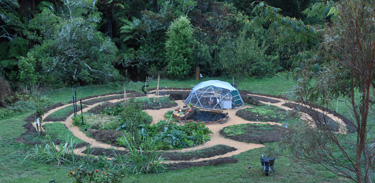
Jase's meticulously planned vege garden is ready for spring planting
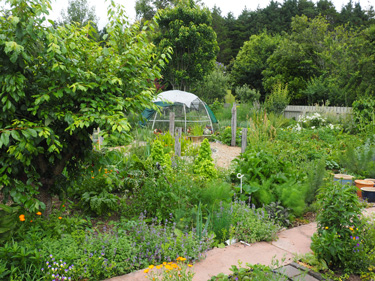
"I love all the fruit and vegetables we grow, and the fact that they are nutirent dense, fresh as and spray free."
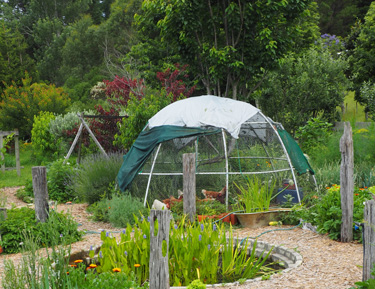
Anne's light but strongly built chicken coops are easily moved around the garden.
